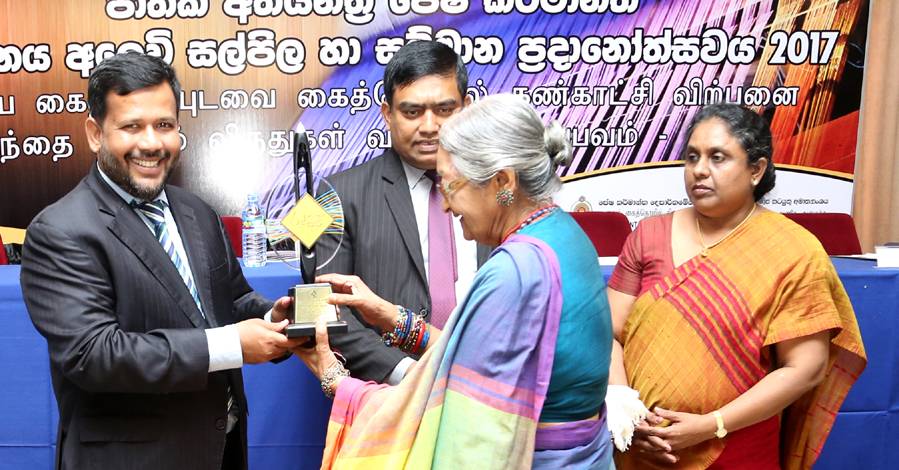After nearly two decades of continued battle for its survival, the handloom sector of Sri Lanka has finally turned around. The change was marked on 15 December by the felicitation of a handloom veteran and by the issuance of the first commemorative postal stamp for Lankan handlooms in Colombo.
“The handloom sector of Sri Lanka faced a setback and declined. However, several government initiatives have successfully revived the sector. Today, many Lankan handloom makers are reaping good profits” said the Minister of Industry and Commerce Rishad Bathiudeen on 15 December, addressing the inauguration of the annual handloom expo and awards event “Ran Salu” by is Ministry. Minister Bathiudeen and many handloom makers at the event witnessed the issuance of a postal stamp by the Postal Department of Sri Lanka commemorating 105 Yr anniversary of the Handloom Textile Training Centre in Rajagiriya.
“I thank all our handloom makers and craftsmen for their contribution to us so far. For the first time in the history of our handlooms, we are issuing a commemorative postal stamp, celebrating our historic handlooms. The handloom sector of Sri Lanka faced a setback and declined, starting from 1990s. However, several government initiatives have successfully revived the sector. Today many Lankan handloom makers are reaping good profits. I am pleased to say that at present, all handloom products made in Sri Lanka are selling fast, and we are unable to meet the demand. Most sales revenues are from the Sri Lankan buyers and the rest of revenues are from tourists” said Minister Bathiudeen, and added: ”Most Lankan handloom makers are in the East. Among the other leading provinces for handlooms are Central, and Southern. The Unity government of HE President Maithripala Sirisena and Prime Minister Ranil Wickremesinghe have plans to improve handloom sector of Sri Lanka, and my Ministry, under this vision, works to promote this sector and supports the handloom makers. 70% of handloom makers are women and therefore strengthening this sector is a way to empower rural women. This sector is also a contributor to government’s self-employment creation plans.”
Speaking of his Ministry’s new initiatives for handloom sector, he said :”Handlooms makers use high quality colourful yarns for their production work. These are expensive. Therefore we are working on a project to make low cost dyes for handloom sector. We are working on establishing a handloom dye and colour centre in the North Central Province with latest technology. Still, it is important for the sector to recognize excellence. After ten years, we have sent Sri Lankan handloom makers to overseas training. We sent 35 Lankan handloom craftsmen to the Indian Institute of Handloom Technology in Salem for training. During this training session, they were also introduced to new market trends. The Ran Salu awards by our Ministry is a celebration of such achievers in this sector.”
Minister Batiudeen also felicitated Ms Chandani Thenuwara-a veteran of Sri Lankan handlooms and who formerly served at the Textiles Department and who was initiated to arts and designs by pioneer Educationist Cora Abraham, of Arts and Free Expression for Children fame, and received a Fellowship to Camberwell College of Arts, South London in 1960s. Sacrificing her opportunity to be wedded and instead, choosing to see the world, she travelled to more than 60 countries, thereafter becoming the first ever British Chartered Woman Textile Technologist in Sri Lanka, earning it in 1970s. “My biggest contribution to Lankan handlooms is introduction of shaded colouring technology to the fabrics which was not possible in pre-1970s” said a jubilant Ms Thenuwara.
Sri Lankan handlooms are also exported now-India being the largest buyer.
